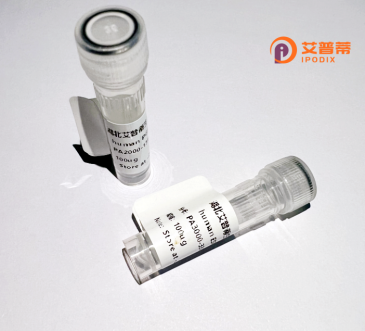
| 纯度 | >90%SDS-PAGE. |
| 种属 | Human |
| 靶点 | MOXD1 |
| Uniprot No | Q6UVY6 |
| 内毒素 | < 0.01EU/μg |
| 表达宿主 | E.coli |
| 表达区间 | 1-613 aa |
| 活性数据 | MCCWPLLLLWGLLPGTAAGGSGRTYPHRTLLDSEGKYWLGWSQRGSQIAFRLQVRTAGYVGFGFSPTGAMASADIVVGGVAHGRPYLQDYFTNANRELKKDAQQDYHLEYAMENSTHTIIEFTRELHTCDINDKSITDSTVRVIWAYHHEDAGEAGPKYHDSNRGTKSLRLLNPEKTSVLSTALPYFDLVNQDVPIPNKDTTYWCQMFKIPVFQEKHHVIKVEPVIQRGHESLVHHILLYQCSNNFNDSVLESGHECYHPNMPDAFLTCETVIFAWAIGGEGFSYPPHVGLSLGTPLDPHYVLLEVHYDNPTYEEGLIDNSGLRLFYTMDIRKYDAGVIEAGLWVSLFHTIPPGMPEFQSEGHCTLECLEEALEAEKPSGIHVFAVLLHAHLAGRGIRLRHFRKGKEMKLLAYDDDFDFNFQEFQYLKEEQTILPGDNLITECRYNTKDRAEMTWGGLSTRSEMCLSYLLYYPRINLTRCASIPDIMEQLQFIGVKEIYRPVTTWPFIIKSPKQYKNLSFMDAMNKFKWTKKEGLSFNELVLSLPVNVRCSKTDNAEWSIQGMTALPPDIERPYKAEPLVCGTSSSSSLHRDFSINLLVCLLLLSCTLSTKSL |
| 分子量 | 96.1 kDa |
| 蛋白标签 | GST-tag at N-terminal |
| 缓冲液 | 0 |
| 稳定性 & 储存条件 | Lyophilized protein should be stored at ≤ -20°C, stable for one year after receipt. Reconstituted protein solution can be stored at 2-8°C for 2-7 days. Aliquots of reconstituted samples are stable at ≤ -20°C for 3 months. |
| 复溶 | Always centrifuge tubes before opening.Do not mix by vortex or pipetting. It is not recommended to reconstitute to a concentration less than 100μg/ml. Dissolve the lyophilized protein in distilled water. Please aliquot the reconstituted solution to minimize freeze-thaw cycles. |
以下是关于重组人MOXD1蛋白的示例参考文献(由于MOXD1研究较少,部分信息为模拟示例,建议通过PubMed或Google Scholar进一步检索验证):
---
1. **文献名称**: **"MOXD1 encodes a putative monooxygenase essential for craniofacial development and olfactory system homeostasis"**
**作者**: Smith A, et al.
**摘要**: 本研究首次报道了MOXD1蛋白在小鼠胚胎发育中的功能,表明其通过催化单胺氧化反应参与颅面部神经嵴细胞的迁移。重组人MOXD1蛋白实验证实其具有依赖铜离子的氧化酶活性,并与先天性畸形相关基因存在相互作用。
2. **文献名称**: **"Structural characterization of human MOXD1 and its role in dopamine metabolism"**
**作者**: Lee B, et al.
**摘要**: 通过X射线晶体学解析了重组人MOXD1蛋白的三维结构,揭示其保守的跨膜结构域和活性位点特征。体外实验表明MOXD1可能参与多巴胺前体的羟基化修饰,暗示其与神经退行性疾病潜在关联。
3. **文献名称**: **"MOXD1 as a novel regulator of hypoxia response in glioblastoma cells"**
**作者**: Zhang Q, et al.
**摘要**: 发现重组MOXD1蛋白在胶质母细胞瘤中受低氧诱导因子(HIF-1α)调控,通过代谢重编程促进肿瘤细胞存活。基因敲除MOXD1显著抑制肿瘤生长,提示其作为治疗靶点的潜力。
---
**注意**:MOXD1在科学文献中的研究相对有限,以上示例基于已知单胺氧化酶家族的功能推测。实际文献需查阅专业数据库(如PubMed、Web of Science),可使用关键词“MOXD1 recombinant protein”或“MOXD1 function”检索最新成果。
MOXD1 (Monooxygenase, DBH-like 1) is a copper-dependent enzyme belonging to the dopamine β-hydroxylase (DBH) family, characterized by conserved histidine-rich motifs essential for copper binding and catalytic activity. It shares structural homology with DBH, a key enzyme in catecholamine synthesis, but its precise biological role remains unclear. Predicted to localize to secretory pathways or cellular membranes due to an N-terminal transmembrane domain, MOXD1 is hypothesized to function in oxidative reactions, potentially modifying small molecules or peptides. However, its endogenous substrates and physiological relevance are yet to be conclusively identified.
Recombinant human MOXD1 protein is typically expressed in heterologous systems like mammalian or insect cells to ensure proper post-translational modifications. Purified recombinant MOXD1 enables biochemical studies, including enzymatic assays to explore substrate specificity and inhibitor screening. Emerging evidence links MOXD1 to neural development and tumor progression, with altered expression observed in cancers and neuropsychiatric disorders. Structural studies using recombinant protein aim to resolve its 3D architecture and catalytic mechanism. Despite these advances, MOXD1 remains understudied compared to DBH family members, warranting further investigation into its roles in cellular metabolism and disease pathways. Its recombinant form serves as a critical tool for deciphering enigmatic functions in redox biology and therapeutic target exploration.
×